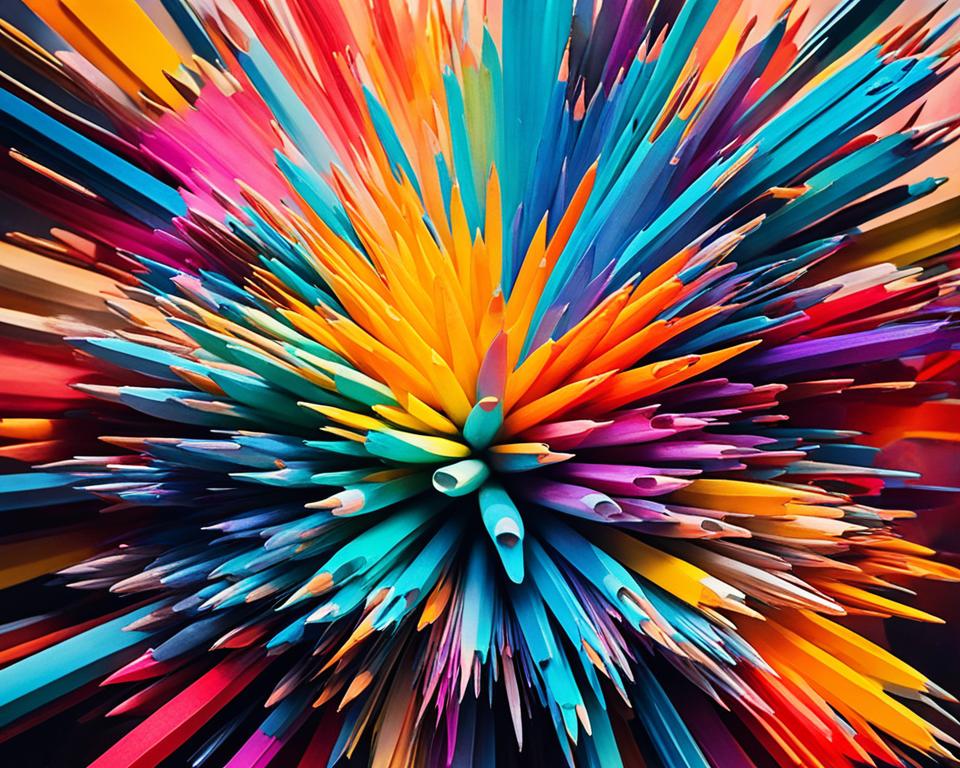Welcome to a captivating journey through the vibrant realm of visual arts. This expansive domain includes a wide range of creative expressions. From the bold brushstrokes of a painter to the mesmerizing light and shadow captured by a photographer, prepare for an adventure. This journey will ignite your imagination and unlock the boundless potential of visual arts.
Visual arts serve as a powerful medium for artists to convey their unique perspectives. They tell stories, evoke emotions, and challenge our perceptions of the world. Whether you’re drawn to painting’s fluidity, drawing’s intricacy, sculpture’s dimensionality, or graphic design’s versatility, this article will guide you through the many facets of this creative landscape.
Key Takeaways
- Discover the diverse range of visual arts, including painting, drawing, sculpture, photography, graphic design, and more.
- Understand the transformative power of visual arts in expressing emotions, telling stories, and shaping our perceptions.
- Explore the techniques and processes that artists employ to bring their creative visions to life.
- Gain insight into the rich history and evolution of visual arts, from traditional to contemporary forms.
- Unlock your own artistic potential and learn how to cultivate your creative voice.
Unleashing Your Artistic Potential
Discovering your creative voice is the initial step in unlocking your artistic potential. By delving into your unique interests and preferences, you can craft a distinctive style. This style will distinguish your work. Whether you’re drawn to vibrant colors, intricate patterns, or minimalist designs, embracing your self-expression is crucial. It’s what makes your artwork resonate with you and your audience.
Discovering Your Creative Voice
Your journey to cultivate your creative voice is one of self-discovery. Experiment with various mediums, techniques, and subjects to find what inspires you. Keeping a sketchbook or journal of your artistic endeavors helps track your style’s evolution. Surround yourself with art that captivates you, and let your influences shape your unique aesthetic without hesitation.
Overcoming Creative Blocks
Even seasoned artists encounter creative blocks. When inspiration seems elusive, try these strategies to spark your creativity:
- Step away from your work and engage in activities that spark joy, such as taking a walk or listening to music.
- Collaborate with other artists to gain fresh perspectives and unlock new creative pathways.
- Reflect on your past successes and the techniques that helped you overcome previous creative challenges.
Artistic potential is not a fixed trait but a dynamic, ever-evolving journey. By embracing your unique creative voice and developing strategies to overcome creative blocks, you can unlock your full creative potential. This approach will help you bring your artistic vision to life.
The Vibrant World of Painting
Painting has captivated artists and viewers for centuries, showcasing a wide array of styles and techniques. From the bold strokes of Impressionism to the detailed realism of the Renaissance, it’s a realm of endless creativity. This section delves into the core elements that define painting, tracing its rich history and versatility.
At its core, painting hinges on color theory, a fundamental aspect that guides artists. Understanding hues, shades, and tones allows painters to evoke emotions and depth. The strategic use of color distinguishes masterpieces across styles, from Fauvism‘s vibrant palette to Cubism‘s subtle harmonies.
Brush techniques are pivotal in shaping a painter’s style. Whether it’s the thick, textured strokes of Expressionism or the smooth blending of Realism, the brushwork significantly influences the artwork. Developing proficiency in brush techniques is an ongoing process, essential for achieving artistic goals.
Painters have consistently expanded their craft, exploring new styles and methods through various art movements. From the groundbreaking Impressionist works to the innovative Abstract Expressionist pieces, painting’s evolution reflects a dynamic journey of artistic exploration and innovation.
“Painting is the grandchild of nature. It is related to God.” – Vincent van Gogh
Drawing: A Fundamental Artistic Expression
Drawing is a captivating art form that serves as the foundation for many visual arts. It’s a means of expression that allows artists to capture the essence of their subjects through the interplay of lines, shapes, and forms. Whether you’re a seasoned artist or a budding creative, mastering the art of drawing and sketching can open up a world of possibilities.
Mastering the Art of Sketching
The key to becoming a skilled sketcher lies in the art of observation. By training your eyes to perceive the world around you with a keen eye for detail, you can translate your visual experiences onto the page. Sketching allows you to experiment with different drawing mediums, from the versatility of pencils to the bold strokes of charcoal and the fluid movements of ink. Through consistent practice and a willingness to explore, you’ll gradually develop your own unique style and artistic voice.
Exploring Different Drawing Mediums
- Pencils offer a wide range of shading and blending techniques, allowing you to create delicate details and soft gradients.
- Charcoal is known for its dramatic, expressive qualities, lending itself to bold, gestural drawings and powerful contrasts.
- Ink pens and brushes provide a fluid, spontaneous approach, encouraging you to embrace the unexpected and explore the dynamic interplay of light and shadow.
Experiment with these diverse drawing mediums to find the tools that resonate most with your artistic vision and personal style. Embrace the process, be patient with yourself, and allow your creativity to flourish as you explore the limitless possibilities of the drawing art form.
Sculpture: Bringing Art to Life in Three Dimensions
Sculpture is an art form that brings three-dimensional works to life, pushing the limits of artistic expression. It spans from the ancient techniques of clay modeling to the modern methods of contemporary sculptors. This field invites us to delve into its rich history and evolution, showcasing the depth of this captivating medium.
Traditional and Contemporary Sculpting Techniques
The art of sculpture is deeply rooted in traditional techniques. Artists have perfected the craft of clay modeling, transforming it into expressive forms. The process of casting bronze sculptures has also been refined over time, enabling the creation of pieces with intricate details and lasting durability.
Contemporary sculptors, however, have expanded the possibilities of three-dimensional art. They experiment with a variety of materials, including stone and found objects. This has led to the creation of visually striking and conceptually deep works that challenge our perceptions and evoke awe.
| Sculpting Technique | Materials | Characteristics |
|---|---|---|
| Clay Modeling | Malleable clay | Allows for intricate details and expressive forms |
| Bronze Casting | Molten bronze | Durable and able to capture fine details |
| Stone Carving | Hard stones like marble, granite, or soapstone | Produces sturdy, long-lasting sculptures with a natural beauty |
The art of sculpture continues to captivate and inspire us, whether we delve into its traditional roots or explore modern innovations. It brings three-dimensional art to life in extraordinary ways, showcasing the boundless potential of this medium.
The Visual Arts of Photography
Photography is a captivating medium that allows artists to capture the world around them, freezing moments in time and evoking powerful emotions. This section will explore the art of photography, covering both digital photography and film photography. We’ll also delve into the principles of composition and lighting that transform a simple snapshot into a work of art.
For both seasoned photographers and beginners, grasping the fundamentals of photography can unlock a new world of creative expression. Mastering aperture, shutter speed, and ISO, along with developing an eye for composition, is key to becoming a skilled photographer. This journey is both challenging and rewarding.
The art of photography also involves the subtle nuances of lighting. By experimenting with various lighting setups, you can dramatically change the mood and feel of your images. This allows you to convey a wide range of emotions and narratives.
| Technique | Description |
|---|---|
| Digital Photography | The modern, versatile approach to capturing images using digital sensors and post-processing software. |
| Film Photography | The classic, analog method of capturing images on light-sensitive film, offering a unique aesthetic and tactile experience. |
| Composition | The strategic arrangement of elements within the frame, creating a visually compelling and harmonious image. |
| Lighting | The manipulation of light, both natural and artificial, to shape the mood, depth, and drama of a photograph. |
The art of photography is a captivating fusion of technical mastery and creative expression. By exploring the diverse techniques and principles of this visual medium, you can unlock endless possibilities for capturing the world around you in stunning and evocative ways.
Graphic Design: Where Art Meets Function

In the captivating world of visual arts, graphic design is a unique blend of creativity and practicality. It combines the artistic aspects of visual communication, typography, and layout with the practical needs of branding and effective communication.
Understanding the Principles of Design
Graphic designers are experts in their field, using design principles to create visually striking and impactful works. They strategically employ color and shape, and arrange elements harmoniously to engage audiences. By utilizing typography and layout, they craft visual stories that convey ideas, evoke emotions, and make a lasting impact.
Creating Visual Narratives
Graphic design’s core is its ability to tell stories visually. Designers use their visual communication skills to create narratives that connect with their audience. Whether it’s designing a brand identity, creating an advertisement, or developing an editorial layout, their work combines form and function to captivate and inspire.
| Principles of Graphic Design | Elements of Visual Narratives |
|---|---|
|
|
“Graphic design is the art of conveying a message effectively through visual means.”
Graphic design serves as the creative link between art and function, captivating and inspiring us. It pushes the limits of visual communication and leaves a lasting impact on design.
Ceramics: Shaping Clay into Masterpieces
The ancient art of ceramics has captivated creators and collectors for centuries. It involves skillfully shaping clay into functional and decorative pottery. Ceramic artists have made a lasting impact on the visual arts. Their work ranges from intricate hand-painted glazes to the mesmerizing dance of the potter’s wheel. This timeless medium continues to enchant and inspire.
At the core of ceramics lies the transformation of raw clay into objects of beauty and utility. Artists use the wheel throwing technique or the more hands-on method of hand-building. They exploit the malleable nature of clay to create works that go beyond their beginnings.
Ceramics also carries deep cultural and historical significance. It has been a canvas for artistic expression and storytelling. From the elegant tea bowls of the Japanese tea ceremony to the vibrant, hand-painted tiles in Moorish palaces, ceramics has long been a medium for creativity.
| Ceramic Techniques | Description |
|---|---|
| Wheel Throwing | The classic method of shaping clay on a rotating wheel, allowing for the creation of symmetrical, rounded forms. |
| Hand-Building | A more tactile approach that involves sculpting clay using techniques like pinching, coiling, and slab-building. |
| Glazing | The application of a glassy, vitreous coating to the surface of ceramic pieces, adding color, texture, and a protective layer. |
Exploring ceramics reveals a rich tapestry of artistic expression, cultural heritage, and timeless beauty. From the humble beginnings of clay to the shimmering glazes and the graceful forms, pottery continues to captivate and inspire us all.
“Ceramics is the art of the earth. It’s something that goes back to the dawn of civilization.”
– Annette Messager, French artist
Printmaking: A Legacy of Artistic Expression
Printmaking has been a captivating art form for centuries, captivating artists and enthusiasts. It allows for the creation of unique, reproducible works through various techniques. These include the intricate etching process and the bold, vibrant methods of screen and woodblock printing.
Exploring Various Printmaking Techniques
Etching is a well-known technique that involves using a metal plate, acid, and a sharp tool to create an image. The plate is then inked and pressed onto paper, resulting in a detailed, textured impression. Lithography uses the repellent properties of oil and water to create prints, enabling artists to achieve a wide range of tones and textures.
Screen printing offers a hands-on approach, allowing for the layering of colors and the creation of bold, graphic designs. This method employs a mesh screen, stencils, and ink to transfer an image onto a surface, producing a striking final product.
Woodblock printing is another technique with ancient roots. Artists carve an image into a wooden block and then press it onto paper. This method creates intricate, textured prints that highlight the natural beauty of the material.
“Printmaking is not just a means of reproduction, but a unique art form in its own right, allowing artists to express their creativity in a multitude of ways.”
Whether you’re drawn to the delicate lines of etching, the vibrant colors of screen printing, or the organic textures of woodblock printing, printmaking offers a rich tapestry of artistic expression. It invites you to explore and appreciate the diverse ways artists can express themselves.
Illustration: Telling Stories Through Visual Arts
In the captivating world of visual arts, illustration stands out as a powerful medium. It allows artists to bring their imagination to life. Through enchanting narratives, viewers are transported to realms of creativity and wonder. From whimsical illustrations in children’s books to thought-provoking digital art on magazine covers, visual storytelling evokes emotions and conveys ideas, leaving a lasting impression.
Illustration spans a wide range of traditional media, including pencils, brushes, and paints. It also incorporates digital art tools and software. Artists use their skills and creativity to craft illustrations that capture a story’s essence. Whether it’s a fantastical adventure, a poignant social commentary, or a slice of everyday life, their work brings stories to life.
The versatility of illustration is its greatest strength. Illustrators can choose from a variety of styles, from delicate and intricate to bold and abstract. Each style is tailored to the project’s needs or the desired emotional response. Through their expertise in line, color, and composition, artists create captivating visual tapestries. These artworks captivate the viewer and leave a lasting impression.
| Illustration Techniques | Artistic Mediums |
|---|---|
| Digital Painting | Pencils |
| Pen and Ink | Acrylics |
| Mixed Media | Watercolors |
| Collage | Digital Brushes |
The art of illustration continues to captivate and inspire audiences globally. Whether it’s a captivating book cover, a thought-provoking magazine illustration, or a whimsical animation, it invites us to explore new perspectives. Through visual storytelling, illustrators spark our imagination and reveal the infinite possibilities of the creative mind.
“Illustration is not just a pretty picture; it’s a way to tell a story, to communicate an idea, to touch the heart and mind of the viewer.”
The Fascinating History of Visual Arts
The visual arts world is a captivating blend of human creativity and expression, covering centuries. It includes a rich variety of styles and movements. We’ll delve into the evolution of art, from the timeless works of the Renaissance to the innovative techniques of Impressionism and the daring approaches of modern art.
Tracing the Evolution of Art Movements
The art world has seen significant changes over the centuries. Each era has left a lasting impact on art history and art movements. The journey from the Renaissance’s naturalistic representations to the Impressionists’ bold brushstrokes and modern art’s abstract explorations is dynamic and ever-changing.
The Renaissance brought a renewed focus on classical antiquity, leading to the rise of artists like Leonardo da Vinci, Michelangelo, and Raphael. They transformed painting, sculpture, and architecture with their innovative techniques and visionary ideas. The Impressionist movement then challenged traditional art forms, focusing on light, color, and everyday life’s fleeting moments.
In the 20th century, modern art movements like Cubism, Fauvism, and Surrealism emerged. These movements broke traditional artistic boundaries, opening up a more experimental and avant-garde approach to visual arts.
The evolution of these art movements reflects the changing cultural landscapes and societal shifts over time. It also showcases the boundless human imagination that has shaped visual arts. Each era has inspired and challenged future artists, encouraging them to explore new possibilities.
Embracing the World of Visual Arts
Our journey through the visual arts has just begun, inviting you to explore the vast possibilities ahead. Whether you’re an aspiring artist, a seasoned creative, or someone who appreciates visual beauty, this journey has only scratched the surface. The world of visual arts is vast and inspiring, full of opportunities waiting to be discovered.
Start your own artistic journey, where creativity knows no bounds. Find your unique voice and contribute to the evolving world of human expression. The visual arts serve as a canvas for self-discovery, allowing you to explore various mediums and techniques. Cultivate your own visual language and express yourself uniquely.
Dive into the realms of painting, drawing, sculpture, photography, and more. Unlock your creative potential as your artistic journey progresses, stroke by stroke, sketch by sketch, and masterpiece by masterpiece. Visual arts empower you to express emotions, tell stories, and leave a lasting impact on the world.





